The Victor-Victrola Page
A Quick History of the Victor
Phonograph
The foundations for the Victor Talking Machine
Company date back to the late 1880's, when a creative entrepreneur named Emile
Berliner invented the mass-production flat phonograph record. Thomas Edison had
invented the
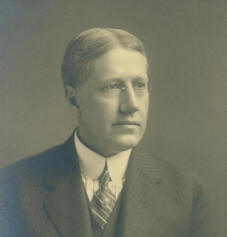 cylinder
phonograph ten years earlier in 1877, but there was no
practical way to mass-duplicate his cylinders at that time. Berliner's flat-disc
design allowed copies to be made of audio recordings in the manner of a printing press. The story
of Victor's emergence as the giant in the phonograph industry is complex, and
many comprehensive descriptions can be found online; but as
a brief summary, Berliner asked Eldridge Johnson (picture at left), the owner of a small machine
shop in Camden, New Jersey, to assist him in developing and manufacturing a
low-cost spring-wound motor for his disc phonograph. The resulting product
showed much promise, and Berliner continued to expand his phonograph operations.
However, there were already several competitors in the mix who were
battling for a share of the growing market for these early talking machines.
Berliner had limited capital to support his new business, but his tenacious
efforts kept the operation going for a few years despite a legal "free-for-all" between rival business owners.
Competitors charged each other with patent
infringements and dishonest practices via a seemingly endless
stream of litigation. Berliner was eventually forced out of the market in the USA, and subsequently moved to
Montreal Canada where he continued his phonograph production operations. Through
hard work, the development of strong partnerships and astute business decisions, Eldridge Johnson
soon emerged as the dominant force in the business using the Berliner patents as
the basis for his products, and incorporated his new
operations as the "Consolidated Talking Machine Company". The business was
reorganized in the fall of 1901 as "The
Victor Talking Machine Company". Victor quickly became the major player in the
explosively growing phonograph market.
From his experiences in working with Mr. Berliner, Johnson had already learned a great deal about the emerging home
entertainment market, as well as in the efficient production of phonographs. In
1901, phonographs were still basically "crude novelties", which neither sounded
very good, nor performed very reliably. But people loved the idea of listening
to bands play, or to hear an opera singer belt-out a Wagnerian masterpiece. And
many opportunities for improvement of this novel invention were quickly
identified.
cylinder
phonograph ten years earlier in 1877, but there was no
practical way to mass-duplicate his cylinders at that time. Berliner's flat-disc
design allowed copies to be made of audio recordings in the manner of a printing press. The story
of Victor's emergence as the giant in the phonograph industry is complex, and
many comprehensive descriptions can be found online; but as
a brief summary, Berliner asked Eldridge Johnson (picture at left), the owner of a small machine
shop in Camden, New Jersey, to assist him in developing and manufacturing a
low-cost spring-wound motor for his disc phonograph. The resulting product
showed much promise, and Berliner continued to expand his phonograph operations.
However, there were already several competitors in the mix who were
battling for a share of the growing market for these early talking machines.
Berliner had limited capital to support his new business, but his tenacious
efforts kept the operation going for a few years despite a legal "free-for-all" between rival business owners.
Competitors charged each other with patent
infringements and dishonest practices via a seemingly endless
stream of litigation. Berliner was eventually forced out of the market in the USA, and subsequently moved to
Montreal Canada where he continued his phonograph production operations. Through
hard work, the development of strong partnerships and astute business decisions, Eldridge Johnson
soon emerged as the dominant force in the business using the Berliner patents as
the basis for his products, and incorporated his new
operations as the "Consolidated Talking Machine Company". The business was
reorganized in the fall of 1901 as "The
Victor Talking Machine Company". Victor quickly became the major player in the
explosively growing phonograph market.
From his experiences in working with Mr. Berliner, Johnson had already learned a great deal about the emerging home
entertainment market, as well as in the efficient production of phonographs. In
1901, phonographs were still basically "crude novelties", which neither sounded
very good, nor performed very reliably. But people loved the idea of listening
to bands play, or to hear an opera singer belt-out a Wagnerian masterpiece. And
many opportunities for improvement of this novel invention were quickly
identified.
One of the first steps Johnson undertook was to
aggressively promote his
business through extensive magazine and newspaper advertising, and to adopt an
unmistakable logo for his brand identification. Emile Berliner had purchased the
US rights to the famous dog-and-phonograph picture from British painter Francis
Barraud several years beforehand, but did not make much use of it. By the end of
1901, Johnson made certain that the unforgettable logo was present on every
machine, record, component, advertisement and catalog. It didn't take long for
"Nipper" sitting in front of his phonograph to become a timeless global icon.
By the end of 1901, victurally all Victor products used both the Victor name and famous "Nipper" logo as an official product identification.
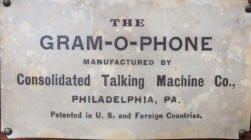
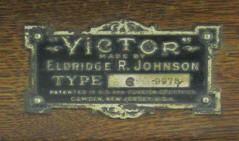
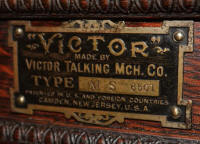
Eldridge Johnson's earliest
phonograph business was operated as the "Consolidated Talking Machine
Co. and this name appeared on tags attached to his machines. The "Victor"
name for his products (along with his name) was adopted shortly thereafter. Victor was formally incorporated
as "The Victor Talking Machine Company" in October 1901. The famous "dog and
phonograph" logo began appearing on most machines by
the end of that year.
Johnson
(and his growing staff) made numerous improvements to the phonograph in those
early years, including a tapered tonearm and new soundbox designs (both of which
improved sound quality) and the production of quiet, stable-running spring motors.
Records also became less noisy through improved manufacturing processes. The phonograph market
began to grow dramatically, and due to a creative and well-funded advertising
campaign, Victor's sales steadily increased. Johnson cleverly arranged to have
renown opera stars and musicians endorse his products, which spurred additional
sales at an advertising cost of almost 50% of the company's total profit. His
business boomed. However, by 1905, growing competition from other manufacturers and
increasing consumer resistance to the design of these early machines began to
restrict Victor's growth.
At that time, all phonograph manufacturers used various types of external horns to "amplify" the
playback sound. While customers wanted more volume and clearer sound quality
from their machines, the only way this could be achieved was to increase the
size of the horn. While these big machines worked well, the stark and
ever-expanding horns tended to overwhelm the average parlor and some people felt that it created an unsightly appearance. To make
matters worse, the big protruding horns were prone to collecting dust or being bumped and damaged (picture at left)
and many potential buyers refused to put such a monstrosity in their homes.
Victor's profits were continually being threatened by patent
infringements; competing businesses were producing variations of essentially the
same product and were at each other's throats (legally) in an attempt to
dominate the growing phonograph business.
Victor eventually won most of the lawsuits (thanks to some very expensive legal
representation), but sustaining strong profits through the fierce competition
and legal turmoils was certainly a challenge. Victor needed a new and unique
product to distance themselves from the competition and to improve the pubic
acceptance of the home phonograph. This would require the elimination of the big
awkward horn and yet still maintain good audio
performance. Therefore, as early as 1904, Victor
began to experiment with a novel idea to make the phonograph more acceptable and
convenient. The horn was folded downward into a large floor-standing cabinet, so
that the horn opening was now below the turntable. Two doors were used to cover the
opening in front of the cabinet. This concept had an added advantage in that the doors acted as a crude
but effective "volume control"; when they were open, the sound was
loud, when they were closed, the volume was reduced. In addition, a lid could
now be closed over the turntable, reducing the surface noise from records. Extra space in the
large cabinet could be used to store records and accessories.
This idea was quickly
patented, and the copyrighted name "Victrola"
was given to this new invention. Unlike previous tabletop phonographs,
the Victrola was a large floor-standing machine. Victor did not have the production
facilities to make a large floor cabinet at that time, so the Pooley Furniture Company of
Philadelphia was contracted to produce a limited quantity of custom-designed cabinets
for these machines.
This novel invention was
aggressively marketed as the new "Victor-Victrola", and advertising
for this product appeared in all
major magazines during the summer of 1906. Once the batch of special-order empty
cabinets arrived at Victor's plant, they were assembled using the company's best
gold-plated phonograph hardware and mechanics, and were quickly distributed
across the country. Select dealers in wealthy urban areas were chosen to display the new product, and the price-tag was set at a very lofty
$200.00 (which equates to about $5,700.00 in today's money) to see how it would
sell. There was likely some skepticism from Victor's management team, as this
was a very expensive offering. Obviously, the new Victor-Victrola was intended
for very affluent customers. In spite of the
cost,
the new Victrolas sold very briskly, and the initial production run was soon
gone. Victor knew it had an immediate hit on its hands. Production for a second
batch was immediately scheduled. And the strongly defended Victrola patents gave
Victor a huge competitive edge over other phonograph makers; as a result, Victor
soon dominated the entire
talking machine industry.
The original Victrola design has several deficiencies though; the most problematic one being the need for the user to awkwardly "reach way down" into the deep cabinet opening on top in order to change a record or lift the tonearm (picture at right). In less than a year, this was soon resolved through the use of a domed lid, which allowed the turntable and tone arm to sit nearly flush on top of the cabinet. Only several thousand of these early flat-lid "Pooley" Victrolas were produced, making them highly sought-after by collectors today.
The earliest Victrolas were designated by a "VTLA" (an abbreviation for Victrola) identification on the dataplate. In 1907, the new Victor-Victrola was being marketed as "Victrola the Sixteenth", a model name which remained in-use for the company's 'flagship' model until 1921. Production ramped-up quickly; the VTLA identification was eventually superseded with the Roman Numerals "VV-XVI" (for Victor Victrola Sixteen) on the dataplate to better correspond with the "Victrola the Sixteenth" designation used in the product brochures and advertising. Victor rapidly expanded its manufacturing operations to make the VV-XVI cabinets in-house, and the services of Pooley were phased-out. Victor also catered to customers by adding an increasing array of finish choices, including oak, walnut, and even custom hand-painted versions. Victor also experimented with selling an even more deluxe model, designated "Victrola the Twentieth", which sold for a whopping $300.00, featuring cross-cut veneers, and gold trim on the cabinet. Only a few hundred of these models were produced before being quietly discontinued. It is important to note that Victor continued to manufacture external-horn machines up into the early 1920's, although in rapidly diminishing numbers. Total production of external horn models in 1905 was more than 65,000 units; by 1912 it had dropped to 19,000 and it fell to just over 9,000 units in 1919. Apparently some customers preferred the older designs, but they were a small minority of buyers. By 1911, the Victrola had become the company's primary product line.
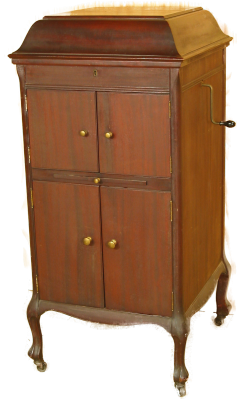 Johnson
knew he had struck gold with his Victrola. By 1909, approximately 15,000 XVI's
had been sold (at $200.00 each) and he decided to capitalize
on his success by introducing a lower-priced model. That same year, the tabletop
Victrola VV-XII was introduced, selling for $125.00 This first attempt to make a
smaller and less costly Victrola was not successful, as the horn opening in the
cabinet was too small
for adequate volume in a large room. In 1910, two new tabletop models replaced the XII;
the Victrola X ($75.00) and Victrola XI ($100.00). These tabletop models had
much better performance than the XII, and began to sell quite well, even though
the price was still prohibitive for many Americans. A smaller version of the
VV-XVI was also introduced, named Victrola the Fourteenth or VV-XIV
($150.00) (picture at left).
Johnson
knew he had struck gold with his Victrola. By 1909, approximately 15,000 XVI's
had been sold (at $200.00 each) and he decided to capitalize
on his success by introducing a lower-priced model. That same year, the tabletop
Victrola VV-XII was introduced, selling for $125.00 This first attempt to make a
smaller and less costly Victrola was not successful, as the horn opening in the
cabinet was too small
for adequate volume in a large room. In 1910, two new tabletop models replaced the XII;
the Victrola X ($75.00) and Victrola XI ($100.00). These tabletop models had
much better performance than the XII, and began to sell quite well, even though
the price was still prohibitive for many Americans. A smaller version of the
VV-XVI was also introduced, named Victrola the Fourteenth or VV-XIV
($150.00) (picture at left).
In 1911, with an eye on the average family budget, Victor introduced several new low-priced models, the VV-IV, VV-VI, VV-VIII and VV-IX, with prices ranging from a remarkable $15.00 up to $50.00. Shortly thereafter, the VV-X and VV-XI were converted from tabletop models to low-priced floor models, which soon became the biggest-sellers in Victor's entire product lineup.
The new low-priced
talking machines were a smashing success, and annual Victrola production rose from
several thousand per year in 1906, to approximately 250,000 annually by 1913.
While the Victrola model lineup remained relatively unchanged through World War
I, several deluxe models were introduced in the mid-to-late 'teens, including
the VV-XVIII ($300.00) and the VV-XVII
($250.00). By 1917, Victor was making
well over one-half
million Victrolas per year. The VV-XI floor model was the most popular of
all, selling over 850,000 copies during its production run (1910-1921). For the
wealthy customer, Victrolas were also available in a variety of custom designs,
with hand painted images, exotic wood, and Japanese lacquer finishes. These
machines were produced in low quantities, and are highly desirable today. While
several strong competitors were still present in 1917, Victor was now the
"elephant in the room" when it came to phonograph sales and marketing. Nobody
else came close.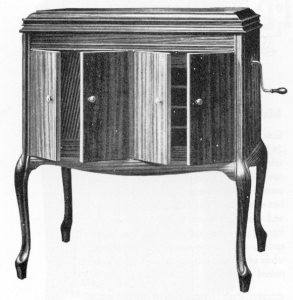 "Victrola" had become a household word. Company profits were incredible, and the
lucky few businessman who were stockholders became immensely wealthy. In 1919,
Eldridge Johnson's wealth was estimated at over $37,000,00.00 which equates to
over 1/2 Billion dollars today. Victor's Camden, NJ plant grew into an
enormous complex of buildings, including their own train yard and power-plant. Pretty good for a machinist who
struggled to survive in 1899.
"Victrola" had become a household word. Company profits were incredible, and the
lucky few businessman who were stockholders became immensely wealthy. In 1919,
Eldridge Johnson's wealth was estimated at over $37,000,00.00 which equates to
over 1/2 Billion dollars today. Victor's Camden, NJ plant grew into an
enormous complex of buildings, including their own train yard and power-plant. Pretty good for a machinist who
struggled to survive in 1899.
In 1913, the first electric motor option became available on the Victrola XVI, eliminating the need for cranking after every few records were played. Victrolas with electric motors were called "Electrolas". This option didn't really catch-on until well into the 1920's, as electrical power was not yet readily available in most parts of the country and the added cost of the electric motor was prohibitive for most buyers.
Due to national defense
needs, phonograph production decreased during World War I (1917-1918). Victor transitioned
their immense production
capacity to make biplane wings, rifles, and other war materials. When the war was over, the demand
for phonographs remained strong, but Victor found that it suddenly had a lot of new competition from
small upstart companies, who often made cheaper (and usually inferior)
phonographs. Many of Victor's patents which protected their unique and
successful designs had expired during the war, leaving the phonograph business
"wide-open" to anyone who wished to compete after the hostilities ended. A great
many phonograph sales began to be lost to the low-priced competitors. In response, the
company redesigned much of their phonograph lineup in the early 1920's with scores of new models, including some
horizontal console styles such as the VV-210 ($100.00) (picture at right)
and the VV-300 ($250.00). These models sold well for a
while, but the wide availability of low-cost phonographs and the increasing
popularity of newly-developed home radios began to take a serious toll on
Victor's business. Radio offered endless variety, better sound quality, and best
of all, the consumer didn't need to purchase records. While Victrola production
continued to run at a fairly steady pace, profits began suffering.
Management was not paying attention to the fact that much of their production
output was being stacked-up in warehouses all over the country, with dwindling consumer demand being felt in the marketplace.
Plus, an endless expansion program, including new manufacturing operations on
the West Coast and in South America were draining cash rapidly. A
public stock offering brought-in some much needed capital investment, but this
was not enough to keep Victor afloat in the waning marketplace. By
1924, Victor realized that radio was a serious threat and half-heartedly offered a few phonographs (with an "S" prefix before the
model identification) that would allow an aftermarket radio to be installed in
the phonograph cabinet alongside the turntable, using the Victrola's horn as a
"speaker". This did little to improve sales; why not just buy a
nice radio set?
In late 1924, the bottom literally fell out of the phonograph
business. By Christmas of that year, many tens of
thousands of unsold Victrolas were sitting in warehouses, and retail sales had
dwindled to a trickle. Customers passed-over obsolete Victrolas in favor of a
modern and impressive radio. The company's operating cash
had also evaporated. Panic set-in at Victor's corporate office and production lines were
suddenly shut-down, with a huge layoff of workers. In order
to move this massive inventory of warehoused machines, a highly publicized sale
was held during the summer of 1925, wherein every unsold Victrola would be
offered at half the list price.
Both dealers and the company "ate" the financial losses just to get the stale products
out of their warehouses. The half-price sale was a success, but the valuation of
Victrolas, and the market value of the entire company, took a serious
tumble. Dealers who had sold an elegant VV-125 to a customer for $275 in early
1924 would offer only $25 for the same model as a trade-in for a radio one year
later (and today we think that computers and cars depreciate fast!!). To boost
radio sales, some dealers would hold "trade-in bonfires". The near-worthless
inventory of Victrola trade-ins would be burned on the public square
as an advertising campaign. Obviously, this created bad press for the
company. Victor stock had become virtually worthless by the spring of 1925. And
any remaining machines that were not sold at the half-price sale were either
destroyed or shipped-off to Central and South America to be dumped in
those markets. In order to survive, Victor started making various furniture and
flooring products; any idea that could make some money
was considered.
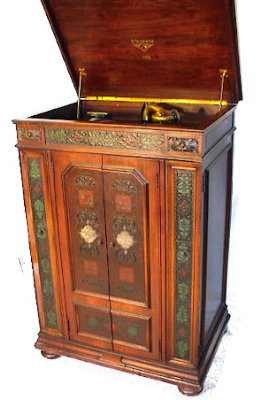 In
a panic development campaign in conjunction with Western Electric
engineers, Victor introduced the "Orthophonic"
line of phonographs in the fall of 1925, which utilized the
latest sound reproducing technology and offered vastly superior reproduction. Scientific improvements were made in the design of the horns and the soundboxes, in-part
based on signal transmission theory developed during World War I. It was a
dramatic improvement. Old-style Victrolas sounded anemic compared to these
new machines. This was
achieved without the use of electronics, though the application of sophisticated
acoustic matched-impedance designs. The tinny Victrola sound was now
replaced with a rich tone that was superior to all but the best radios. In
addition, phonograph records were for the first time being recorded
electrically, which also improved the sound quality. Selling for as little
as $50.00 (and for more than $300.00), these new machines were an immediate
success, and quickly brought profitability (and prestige) back to Victor.
The "Credenza" was the flagship of this new line, and its audio
performance is dramatic, even by today's standards (picture at left).
In
a panic development campaign in conjunction with Western Electric
engineers, Victor introduced the "Orthophonic"
line of phonographs in the fall of 1925, which utilized the
latest sound reproducing technology and offered vastly superior reproduction. Scientific improvements were made in the design of the horns and the soundboxes, in-part
based on signal transmission theory developed during World War I. It was a
dramatic improvement. Old-style Victrolas sounded anemic compared to these
new machines. This was
achieved without the use of electronics, though the application of sophisticated
acoustic matched-impedance designs. The tinny Victrola sound was now
replaced with a rich tone that was superior to all but the best radios. In
addition, phonograph records were for the first time being recorded
electrically, which also improved the sound quality. Selling for as little
as $50.00 (and for more than $300.00), these new machines were an immediate
success, and quickly brought profitability (and prestige) back to Victor.
The "Credenza" was the flagship of this new line, and its audio
performance is dramatic, even by today's standards (picture at left).
The rapid expansion of the radio market, and the introduction of AC power into most homes caused a massive increase in the production of electronic components such as tubes and transformers, with a corresponding decrease in prices of new power amplifiers and speaker systems. In 1924, electronic audio systems were virtually unaffordable. By the late-1920's, prices of tubes and other components had fallen to the point where many buyers could purchase electronically-amplified phonographs. New combination radio-phonograph sets were also becoming quite popular. These early 'home entertainment systems' could use the radio's amplifier for reproducing records, and the large acoustic horn was replaced by a small paper-cone speaker. Fidelity was again improved, and the "volume control" used in electronic amplifiers offered precise control of the sound level in any room (rather than opening and closing the phonograph doors). Some models even had sophisticated record changers, which would allow a complete symphony to be played without having to stop and manually change records. Victor entered into an agreement with The Radio Corporation of America (RCA) for the use of RCA's electronics in many of Victor's products, and the company produced a number of radio-phono combination sets which were quite successful. But by the late 1920's, Victor's founder, Eldridge Johnson, having almost lost his company in the collapse of 1925, was growing weary of the business and decided to retire. Victor was sold to an investment banking group. Then in late 1929, RCA purchased The Victor Talking Machine Company, and the new company was called "RCA Victor". By this time, the popularity of the acoustic phonograph was quickly diminishing in favor of the louder and more flexible electronic radio/phono combination systems, and only cheap portables and children's phonographs continued to utilize acoustic reproduction. In October 1929, the onset of The Depression literally killed the sales of all non-essential commodities, and not until the late 1930's did RCA Victor again experience significant profits from the sale of phonographs.
